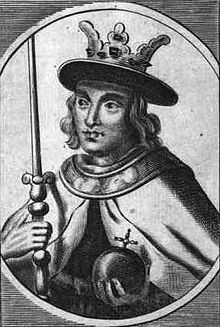Harald Hen
Harald Hen (* 1041 ; † April 17, 1080 ) was King of Denmark from 1076 to 1080 . His nickname "Hen" means "whetstone", which was associated with "soft". The epithet can also refer to the sword-shaped whetstone, as it is used today for scythes, unusable compared to the real sword. He was evidently upset by his opponents, for whom he was not combative enough.
Life
He was the eldest but illegitimate son of his predecessor Sven Estridsson and married to Margrete Asbjørnsdatter.
In 1069 he took part in a campaign to England , where the Danes tried to expel William the Conqueror with the support of locals who were dissatisfied with his rule. The army was badly led and had nothing to oppose the heavy cavalry of the Normans . The move was therefore unsuccessful.
After Sven Estridsson's death, there were two aspirants to the throne: Harald Hen and his brother Knut the Holy . In 1076 there was an election in northern Zealand . Harald was considered to be peace-loving, while Knut seemed to want to entangle Denmark in a protracted war with the Normans in England. So the chiefs chose Harald as king. Apart from conflicts with his brothers Knut Svensson and Erik Ejegod , his style of government was focused on peace. He continued the church-friendly policies of his father and looked for a good relationship with Pope Gregory VII. He strengthened his conflict with his brothers. In conflicts between chiefs and peasants, he often sided with the peasants. The large forests of the crown estate were made accessible and usable for everyone against the resistance of the nobility, who had previously been the only one entitled. In the judiciary, he abolished the iron sample as evidence. He is also said to have stood behind the coin reform that more recent research attributed to his father. Six different types of coins are known that were minted in Lund , Roskilde , Viborg , Slagelse and Thumatorp . It is associated with the introduction of the royal monopoly on coins, the restriction of mints and the introduction of the death penalty on counterfeiting.
In the sources he was valued differently: The Roskilde Chronicle regarded him as a righteous king, Saxo Grammaticus as a weak and poorly assertive one. He was later believed to be a democratic king, a king for the people, not over the people. In some ways he resembled his contemporary Olav Kyrre of Norway.
He died with no offspring. His grave is in Dalby Church in Skåne .
See also
Web links
| predecessor | Office | successor |
|---|---|---|
| Sven Estridsson |
King of Denmark 1076-1080 |
Canute IV. The saint |
| personal data | |
|---|---|
| SURNAME | Harald Hen |
| ALTERNATIVE NAMES | Harald III. |
| BRIEF DESCRIPTION | King of Denmark |
| DATE OF BIRTH | 1041 |
| DATE OF DEATH | April 17, 1080 |

